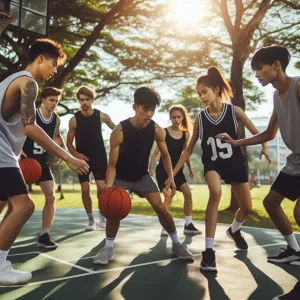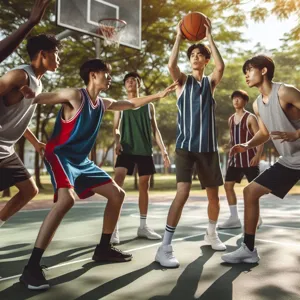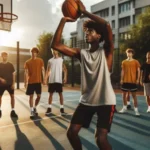As the final buzzer sounds and the basketball season comes to a close, many aspiring players might feel tempted to hang up their sneakers and take a break.
However, the off-season is a golden opportunity to elevate your game and set yourself apart from the competition. This is the time to hone your skills, build your strength, and develop a deeper understanding of the game. Whether you’re looking to improve your shooting accuracy, enhance your agility, or strengthen your mental resilience, the right training regimen can make all the difference. In this blog post, we’ll explore essential training tips that will help you maximize your off-season, ensuring you return to the court stronger, sharper, and more prepared than ever to take your basketball aspirations to new heights. Get ready to unleash your potential and transform your skills into a powerful advantage!
1. Understanding the Off-Season: Importance and Benefits

The off-season is often viewed as a downtime for many athletes, a break from the rigorous demands of the competitive season. However, for aspiring basketball players, this period is a golden opportunity that should never be underestimated. Understanding the significance of the off-season is crucial for maximizing your skills, enhancing your game, and preparing for the challenges ahead.
During the off-season, players have the unique advantage of focusing on their individual development without the pressures of games and tournaments. This is the perfect time to refine your technical abilities, work on your shooting form, and develop your ball-handling skills. Unlike the regular season, where practice time is often limited and focused on team strategies, the off-season allows for an intensive, personalized training regimen that can lead to significant improvements.
Moreover, the off-season is an ideal moment to assess your physical condition. Engaging in strength and conditioning exercises helps to build core strength, agility, and endurance—key components that contribute to on-court performance. Whether it’s lifting weights, doing agility drills, or incorporating plyometrics into your routine, the goal is to emerge from the off-season stronger and more athletic than ever.
Additionally, this period of training offers a chance for mental growth. With fewer distractions from games, athletes can delve deeper into studying the game. Watching film, analyzing your own performance, and learning from seasoned pros can provide valuable insights that translate into better decision-making on the court.
Lastly, the off-season is a time to solidify your passion for the sport. By dedicating time to hone your skills, you reinforce your commitment to basketball and set the stage for success in the upcoming season. Remember, the off-season is not merely a break; it’s an essential phase of growth and preparation that can define your trajectory as a basketball player. Embrace it, and you’ll reap the rewards when the season rolls back around.
2. Setting Clear Goals for Your Off-Season Training
Setting clear goals for your off-season training is a crucial step in maximizing your development as a basketball player. Without a well-defined roadmap, it’s easy to drift from one workout to another without making meaningful progress. Goals provide direction and motivation, transforming your training sessions from simple routines into focused missions.
Start by conducting an honest self-assessment of your current skills and physical condition. Identify specific areas where you want to improve, whether it’s enhancing your shooting accuracy, increasing your vertical leap, or developing better defensive techniques. For instance, if you find that your shooting percentage has dipped during the regular season, set a goal to increase it by a certain percentage. This could involve not only dedicated shooting drills but also working on your footwork and shot selection.
Next, make your goals SMART—Specific, Measurable, Achievable, Relevant, and Time-bound. Instead of saying, “I want to be a better shooter,” specify, “I will shoot 200 free throws every practice session and aim to make at least 80% of them by the end of the off-season.” This approach not only clarifies your objectives but also allows you to track your progress over time.
Incorporate both short-term and long-term goals into your training plan. Short-term goals can keep you motivated on a day-to-day basis, while long-term goals offer a bigger picture of your aspirations, such as making the varsity team or earning a scholarship. Remember, the off-season is an opportunity to build a foundation that will support your future success on the court. By setting clear, actionable goals, you’re not just preparing for the next season—you’re investing in your growth as a player and ensuring that when the next tip-off arrives, you’re ready to shine.
3. Creating a Personalized Training Plan

Creating a personalized training plan is crucial for aspiring basketball players looking to maximize their off-season. Unlike generic workout schedules that may not cater to your unique strengths, weaknesses, and goals, a personalized plan allows you to focus on the specific areas of your game that need improvement. Start by evaluating your current skills: Are you looking to enhance your shooting accuracy, increase your speed, or improve your defensive techniques? Identifying these focal points will help you tailor your training regime effectively.
Begin by setting both short-term and long-term goals. Short-term goals could include mastering a particular dribbling move or improving your free throw percentage, while long-term goals may encompass playing at a higher level or significantly enhancing your overall performance. Once you have your goals in place, break them down into manageable weekly or monthly milestones, allowing for continuous assessment and adjustment as you progress.
Incorporate a variety of training elements into your plan. This should include skill-specific drills, strength and conditioning workouts, agility exercises, and flexibility routines. For example, you might dedicate certain days of the week to shooting drills, while reserving others for weight training or endurance workouts. Additionally, consider including mental training sessions to sharpen your focus and enhance your game strategy. Visualization techniques and mindfulness practices can be invaluable in preparing you for the competitive aspects of basketball.
Finally, remember that consistency is key. A personalized training plan is only effective if you stick to it. Regularly review and adjust your plan based on your progress, and don’t hesitate to seek guidance from coaches or experienced players who can provide valuable insights. By creating and committing to a personalized training plan, you’ll lay a solid foundation for your basketball skills, ensuring you enter the next season not just ready to play, but ready to excel.
4. Strength Training: Building a Solid Foundation
Strength training is a crucial component for any aspiring basketball player looking to maximize their off-season. It’s not just about building bulky muscles; it’s about creating a solid foundation that enhances your performance on the court. By focusing on strength training, you equip your body to handle the physical demands of basketball, from explosive jumps to rapid lateral movements.
Begin with compound exercises that engage multiple muscle groups simultaneously. Squats, deadlifts, and bench presses are excellent for building overall strength and power. These movements mimic the dynamic actions you’ll perform in a game, helping to improve your explosiveness and endurance. Aim to incorporate free weights into your routine, as they promote better coordination and stability compared to machines.
Don’t neglect your core! A strong core is essential for maintaining balance and stability while dribbling, shooting, and defending. Exercises like planks, Russian twists, and medicine ball throws will help you develop the core strength necessary for those quick pivots and sustained movements. Additionally, consider integrating plyometric exercises such as box jumps and burpees, which enhance your power and agility, allowing for quicker first steps and higher jumps.
As you progress, focus on periodization—varying your training intensity and volume to prevent plateaus and reduce the risk of injury. This approach not only keeps your workouts fresh but also ensures your body is continually adapting and improving. To round out your strength training regimen, don’t forget to incorporate flexibility and mobility work. Stretching and mobility drills help maintain joint health, improve range of motion, and reduce the risk of injuries, keeping you in the game longer.
Incorporating these strength training principles into your off-season routine will help you build a solid foundation that translates into improved performance on the court. As you prepare for the upcoming season, remember that the work you put in during these months will pay dividends when the games count. Embrace the grind, stay committed, and watch as your hard work transforms you into a more formidable player.
5. Developing Your Skills: Dribbling, Shooting, and Passing Drills

When it comes to maximizing your off-season, honing your fundamental skills is paramount. Dribbling, shooting, and passing are the cornerstones of basketball, and dedicating time to practice these areas can set you apart on the court.
**Dribbling** is more than just bouncing the ball; it’s about control, speed, and creativity. Start with basic drills like the stationary pound dribble, where you maintain a low stance and alternate hands, focusing on keeping your head up to improve court awareness. Once you’re comfortable, progress to cone drills that require you to navigate through obstacles, enhancing your agility and coordination. Incorporating change-of-pace moves, such as hesitation dribbles and crossovers, will help you become unpredictable to defenders, giving you an edge during games.
**Shooting** is an art that requires both technique and repetition. Begin with form shooting from close range, emphasizing proper hand placement and follow-through. As you become more consistent, gradually extend your range. Incorporate drills like “Around the World,” where you shoot from various spots on the court, and “Spot Shooting,” which focuses on shooting off the catch. Don’t forget about shooting under pressure—simulate game scenarios by timing your shots or adding a defender to improve your mental toughness and decision-making.
**Passing** is often overlooked, yet it is crucial for effective teamwork. Work on the basic chest pass, bounce pass, and overhead pass, ensuring you focus on accuracy and timing. Incorporate partner drills where you pass the ball back and forth while moving, gradually increasing distance and speed. To elevate your skill level, engage in passing drills that require quick decision-making, such as three-man weave or passing against a wall. These exercises not only enhance your passing ability but also help you develop better court vision and anticipation.
Remember, the key to improvement is consistency. Set specific goals for each skill and dedicate time to practice them regularly. As you develop your dribbling, shooting, and passing skills, you’ll not only enhance your performance but also build the confidence needed to excel when the season begins. Embrace the off-season as an opportunity to refine your game, and you’ll be ready to take on any challenge that comes your way.
6. Cardiovascular Conditioning: Improving Endurance and Stamina
Cardiovascular conditioning is a cornerstone of any aspiring basketball player’s off-season training regimen. While skill development and strength training are undoubtedly important, the ability to maintain high energy levels throughout a game can often be the deciding factor between victory and defeat. Basketball is a dynamic sport that demands bursts of speed, agility, and explosive power, all of which require a solid foundation of endurance and stamina.
To effectively enhance your cardiovascular health, consider incorporating a variety of training methods into your routine. Start with traditional forms of cardio such as running or cycling, which can help build your aerobic base. Aim for longer, steady-state sessions at a moderate pace to improve your overall endurance. As you progress, introduce interval training, which mimics the stop-and-go nature of basketball. Alternate between high-intensity sprints and lower-intensity recovery periods to push your limits and enhance your anaerobic capacity.
Don’t overlook the importance of sport-specific drills that can elevate your heart rate while simulating game-like scenarios. Drills like full-court sprints, defensive slides, or shuttle runs not only build stamina but also sharpen your skills under fatigue. Incorporating jump rope sessions can also be beneficial, improving coordination and footwork while providing an excellent cardiovascular workout.
Moreover, it’s essential to monitor your progress and adjust your training intensity as you improve. Utilize heart rate monitors or fitness apps to keep track of your performance, ensuring that you’re training in the right zones for optimal results. Remember, consistency is key. By dedicating time to cardiovascular conditioning during the off-season, you’re not just preparing your body for the demands of the game; you’re setting yourself up to be a stronger, more resilient player when the season begins. Embrace the grind, and watch as your endurance translates into enhanced performance on the court.
7. Flexibility and Injury Prevention: The Role of Stretching

Flexibility and injury prevention are crucial components of any basketball player’s training regimen, especially during the off-season when athletes have the opportunity to focus on their physical development without the constraints of a demanding game schedule. Stretching plays a pivotal role in this process, helping players improve their range of motion, enhance performance, and reduce the risk of injury.
To begin, incorporating a consistent stretching routine into your training can significantly increase your flexibility. This is essential not only for executing dynamic movements on the court—such as explosive jumps, quick pivots, and swift lateral actions—but also for maintaining overall body health. When muscles are flexible, they can absorb the stresses of high-impact play more effectively, allowing for smoother movements and greater agility.
Static stretching, where you hold a stretch for an extended period, is beneficial for improving overall flexibility. It’s best to perform these stretches after workouts when your muscles are already warmed up. Focus on key muscle groups used in basketball, such as the hamstrings, quadriceps, calves, hip flexors, and shoulders. Each stretch should be held for at least 20-30 seconds to maximize effectiveness.
Dynamic stretching, on the other hand, is ideal for warming up before practice or games. Incorporating movements such as leg swings, arm circles, and walking lunges can help increase blood flow to your muscles, preparing them for the intensity of a training session. This type of stretching enhances mobility and helps to activate the muscles you’ll rely on during gameplay.
Moreover, injury prevention is paramount in a sport as fast-paced and physically demanding as basketball. A well-structured stretching routine can help identify and address any muscle imbalances or tightness that may lead to injuries. By focusing on flexibility, you’re not just enhancing your performance; you’re also safeguarding your body against strains, sprains, and other common injuries.
In summary, flexibility and injury prevention through regular stretching should be a cornerstone of your off-season training program. By dedicating time to enhance your flexibility, you’ll find yourself not only more agile and capable on the court but also less prone to injuries, allowing you to train harder and longer. Remember, a flexible athlete is a resilient athlete, and this off-season is the perfect time to build a strong foundation for your basketball career.
8. Nutrition Tips for Aspiring Basketball Players
Nutrition plays a pivotal role in the development of aspiring basketball players, especially during the off-season when athletes have the opportunity to focus on building strength, endurance, and overall performance. As a basketball player, your body is your most important asset, and fueling it with the right nutrients can make all the difference in your training and on-court success.
First and foremost, prioritize a balanced diet that includes a mix of carbohydrates, proteins, and healthy fats. Carbohydrates are crucial for providing the energy needed during intense training sessions. Opt for whole grains like brown rice, quinoa, and whole wheat pasta, which release energy slowly and help maintain stamina throughout your workouts. Pairing these with lean proteins, such as chicken, turkey, fish, or plant-based options like beans and legumes, is key to muscle recovery and repair. Aim for a post-workout meal that combines protein and carbohydrates within an hour of finishing your training; this will help replenish energy stores and facilitate muscle growth.
Hydration is another critical aspect of nutrition that is often overlooked. Staying well-hydrated is essential for peak performance, as even slight dehydration can impair athletic abilities. Make it a habit to drink water consistently throughout the day, and consider incorporating electrolyte-rich beverages during and after intense training sessions to replenish lost minerals.
Additionally, don’t shy away from incorporating a variety of fruits and vegetables into your meals. These natural powerhouses are packed with vitamins, minerals, and antioxidants that support immune function and overall health. They can also help reduce inflammation, which is beneficial for recovery after tough workouts or games.
Finally, pay attention to your meal timing. Eating smaller, nutrient-dense meals and snacks throughout the day can help maintain energy levels and prevent fatigue. Think of nutrient-rich snacks like nuts, yogurt, or smoothies made with fruits and greens, which can provide the fuel needed to power through your training sessions.
By focusing on these nutrition tips, you’ll not only maximize your off-season training but also set yourself up for success as you prepare to dominate the court. Remember, what you put into your body directly impacts your performance, so treat your nutrition as seriously as your training.
9. Mental Training: Visualization and Mindset Techniques
In the world of basketball, physical prowess is only part of the equation; mental strength plays an equally crucial role in achieving peak performance. Aspiring players should not overlook the power of mental training, particularly through visualization and mindset techniques. These practices can help athletes sharpen their focus, enhance their confidence, and cultivate a winning mentality, all of which are essential for success both on and off the court.
Visualization is a powerful tool that allows players to mentally rehearse their performances before stepping onto the court. By closing their eyes and picturing themselves executing a perfect shot, making a crucial pass, or confidently defending against an opponent, players can create a strong mental blueprint for success. This technique not only improves muscle memory but also reduces anxiety, allowing athletes to feel more prepared when game time arrives. Encouragingly, studies have shown that the brain often cannot distinguish between a real experience and a vividly imagined one, meaning your practice in visualization can translate into actual performance improvement.
Complementing visualization is the development of a winning mindset. This involves cultivating positive self-talk, setting realistic goals, and learning to embrace challenges rather than shy away from them. Players can practice affirmations, repeating phrases that reinforce their skills and abilities, such as “I am a strong player” or “I can overcome any challenge.” By fostering a resilient mindset, athletes become more adaptable to the ups and downs of training and competition, allowing them to bounce back from setbacks with renewed determination.
Incorporating mental training into your off-season regimen can be as simple as dedicating a few minutes each day to visualization exercises or journaling your goals and reflections. Engaging in mindfulness practices, such as meditation or deep-breathing exercises, can further enhance focus and clarity, setting the stage for a productive training session. By prioritizing mental training alongside physical workouts, aspiring basketball players can maximize their off-season, ensuring they return to the court not just stronger, but also mentally sharper and more confident.
10. The Importance of Rest and Recovery
In the pursuit of excellence on the basketball court, aspiring players often push the limits of their physical and mental endurance. However, one of the most critical components of performance that is frequently overlooked is the importance of rest and recovery. Just as a well-tuned engine requires regular maintenance to perform at its peak, so too do athletes need to allow their bodies time to heal and rejuvenate.
Rest is not merely a break from training—it’s an essential period for muscle repair, injury prevention, and overall growth. While it might be tempting to fill every waking hour with drills and workouts, the reality is that excessive training can lead to burnout and fatigue, ultimately hindering progress. During rest periods, your muscles rebuild, your energy stores replenish, and your mind can recuperate from the mental demands of the game.
Incorporating rest days into your training schedule is vital for sustained improvement. This doesn’t mean complete inactivity; instead, consider active recovery activities such as yoga, swimming, or light jogging. These low-impact exercises can stimulate circulation and promote recovery without straining your body further.
Moreover, prioritizing quality sleep is essential. Sleep is the body’s natural recovery mechanism, allowing for vital processes such as muscle growth and cognitive function to take place. Aim for 7-9 hours of restful sleep each night, and establish a consistent sleep routine to ensure your body can recover effectively.
In addition to physical rest, mental recovery is equally important. Basketball is as much a mental game as it is a physical one, and taking time to decompress can help maintain your passion and focus. Engage in activities that bring you joy outside of basketball, whether it’s spending time with friends, reading, or exploring new hobbies.
Remember, the road to excellence is not a sprint but a marathon. By valuing rest and recovery as integral parts of your training regimen, you’ll set yourself up for long-term success, ensuring that you return to the court refreshed, revitalized, and ready to take your game to the next level.
11. Seeking Feedback: Working with Coaches and Mentors
Seeking feedback is a crucial component of growth for any aspiring basketball player, and working closely with coaches and mentors can provide insights that are simply unattainable through self-assessment alone. Basketball, like any sport, is a complex game that requires not only skill but also a deep understanding of strategy, teamwork, and personal development. Engaging with experienced coaches and mentors can illuminate areas of improvement that you might not even recognize in your own game.
When you train during the off-season, it’s the perfect opportunity to cultivate relationships with those who have the expertise and experience to guide you. Consider scheduling regular one-on-one sessions with your coach, where you can focus on specific skills or strategies. Utilize these moments to ask targeted questions about your performance—whether it’s your shooting technique, ball handling, or defensive positioning. A keen eye can spot nuances that may escape you, and constructive criticism will help you refine your skills.
Moreover, seek mentors who have played at higher levels of the game. Their firsthand experiences and stories can provide invaluable lessons about the mental and physical demands of basketball. They can offer advice on how to maintain focus, build resilience, and navigate the challenges that come with competitive play. Participating in clinics or workshops led by seasoned players can also enrich your understanding of the game and introduce you to new training methods.
Finally, don’t shy away from feedback after games or scrimmages. Embrace a growth mindset by viewing critiques as stepping stones rather than setbacks. Take notes on what you learn and create a plan to implement the changes discussed. Remember, the journey to becoming a skilled basketball player is a continuous process of learning, and the insights gained from coaches and mentors will be instrumental in your off-season training. By actively seeking feedback and applying it diligently, you’re not only enhancing your game but also demonstrating a commitment to personal excellence that will serve you well on and off the court.
12. Engaging in Competitive Play: Joining Off-Season Leagues
Engaging in competitive play by joining off-season leagues can be a game-changer for aspiring basketball players looking to maximize their off-season training. While solo drills and skill development are essential, nothing can replicate the intensity and unpredictability of live games. Off-season leagues provide the perfect opportunity to put your hard work into practice, sharpen your decision-making skills, and develop your basketball IQ in a dynamic environment.
When you join an off-season league, you’re not just playing against opponents; you’re also competing alongside fellow players who share your passion for the game. This environment fosters camaraderie and allows you to learn from others, picking up new techniques and strategies that can enhance your own play. The competition can vary, giving you the chance to challenge yourself against players of different skill levels, from seasoned veterans to up-and-coming talent.
Moreover, participating in these leagues helps you stay game-ready, maintaining your physical conditioning while also fine-tuning your timing and teamwork. You’ll get to experiment with new skills and strategies in real-game situations, which can be crucial for your overall development. This hands-on experience is invaluable when the competitive season rolls around, as you’ll be better equipped to adapt to the pressures and rhythms of a real game.
Don’t underestimate the importance of building a rapport with teammates during these leagues. Effective communication and chemistry on the court can significantly enhance your performance and help you stand out during trials or tryouts for your school or club team. So, lace up those sneakers, hit the courts, and make the most of your off-season by diving headfirst into competitive play. Your future self will thank you!
13. Utilizing Technology: Tracking Progress and Performance
In today’s digital age, aspiring basketball players have an unprecedented advantage when it comes to training and performance enhancement. Utilizing technology to track progress can be a game changer, providing valuable insights that help players refine their skills and elevate their game to the next level.
There are a myriad of apps and devices designed specifically for athletes, allowing you to monitor everything from shooting accuracy to speed and agility. For instance, wearable fitness trackers can measure your heart rate, calories burned, and even your shooting efficiency during practice sessions. This data not only helps you understand your current fitness levels but also aids in setting realistic goals for improvement.
Video analysis tools are another fantastic way to harness technology. By recording your practice sessions, you can break down your techniques and movements frame by frame. This allows you to identify areas of strength and pinpoint specific skills that require further attention—be it your shooting form, defensive positioning, or footwork. Many players have found that watching their own footage helps them learn faster than traditional methods.
Additionally, performance analytics software can aggregate your statistics over time, providing a comprehensive view of your development. By tracking metrics such as points per game, assists, and rebounds, you can gain a clearer picture of your overall performance and the impact of your training regimen.
Don’t overlook the power of social media and online communities, either. Engaging with fellow players, coaches, and trainers on platforms like Instagram or YouTube can provide motivation, new training ideas, and constructive feedback. By sharing your journey and progress, you not only hold yourself accountable but also inspire others in the basketball community.
By integrating these technological tools into your off-season training, you can take a more analytical approach to your development, ensuring that you’re not just working hard, but working smart. Embrace the data, learn from it, and watch as your game transforms in ways you never thought possible.
14. Building a Support System: Finding Training Partners
Building a support system is crucial for aspiring basketball players looking to enhance their skills during the off-season. Training alone can often lead to stagnation, as there’s a limit to what self-motivation can achieve. This is where finding the right training partners comes into play. Not only can a good training partner motivate you to push through tough workouts, but they can also provide valuable feedback and competition that can elevate your game to new heights.
Start by reaching out to teammates, friends, or local players who share your passion for basketball. Look for individuals who are at a similar skill level but also those who challenge you to improve. Training with someone who has strengths in areas where you may be lacking can help you develop a more well-rounded skill set. For instance, if you struggle with shooting, find a partner who excels in that area and can offer tips and drills to improve your accuracy.
Additionally, consider joining local basketball leagues or clubs where you can meet new players. These environments foster camaraderie and create opportunities for collaboration and learning. Group workouts not only make training more enjoyable but also help build a sense of accountability—when you know someone is counting on you to show up, you’re less likely to skip a session.
Communication is key in a training partnership. Establish clear goals that you both want to achieve, whether that’s improving shooting percentages, mastering new plays, or enhancing physical conditioning. Regularly check in with each other to assess progress and adjust training methods as needed.
By building a strong support system of training partners, you’ll not only keep your motivation levels high but also create a fun and dynamic training environment that can lead to significant improvements in your game. As you work together, you’ll forge bonds that extend beyond the court, making the off-season not just a time for skill development, but also for creating lasting friendships within the basketball community.
15. Reflecting on Your Progress: Adapting Your Training Plan
Reflecting on your progress is a crucial step in evolving as a basketball player, especially during the off-season when you have the time and space to make significant improvements. As you clock in hours at the gym, it’s easy to get caught up in the grind and lose sight of your goals. That’s why taking a moment to assess your growth is not just beneficial; it’s essential.
Start by setting aside time each week to evaluate your training sessions. Are you achieving the goals you set for yourself? Have your shooting percentages improved? Do you feel stronger and more agile on the court? Use a journal or an app to track your performance metrics, noting improvements and areas that still require focus. This reflective practice will provide clarity on how far you’ve come and where you need to go next.
Moreover, adapting your training plan based on this reflection is vital. If you find that your shooting technique has plateaued, it may be time to incorporate different drills or seek feedback from a coach or a more experienced player. Conversely, if you’re excelling in one area, consider shifting your focus to another skill set that needs attention, such as defensive strategies or ball-handling.
Don’t be afraid to pivot your training regimen. The off-season is the perfect opportunity to experiment with new techniques, whether that involves cross-training in other sports, increasing your strength training, or even focusing on mental aspects of the game like visualization and strategy.
By regularly reflecting on your progress and adapting your training plan accordingly, you not only ensure continuous improvement but also cultivate a mindset of growth and resilience. This approach will prepare you to return to the court not just as a better player, but as a more dynamic and versatile athlete ready to take on any challenge.
As we wrap up our exploration of essential training tips to maximize your off-season, remember that this period is not just a break from competition, but a golden opportunity for growth and improvement. By embracing the strategies outlined in this post—focusing on skill development, physical conditioning, mental resilience, and nutrition—you can transform your off-season into a launching pad for your basketball aspirations. Whether you’re perfecting your jump shot or building endurance, every moment spent honing your craft will pay dividends when the season resumes. So lace up your sneakers, set your goals, and approach each training session with determination and enthusiasm. With dedication and the right mindset, you’ll be ready to hit the court stronger, faster, and more skilled than ever before. Here’s to a productive off-season and the exciting journey ahead!






